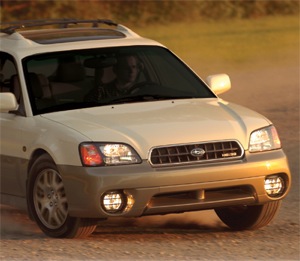 Economical cars are going to be in bigger demand as fuel prices continue to remain unstable. But, having a car that can handle the family and provide the utility needed to take off into the backcountry is still going to appeal to a lot of people.
Economical cars are going to be in bigger demand as fuel prices continue to remain unstable. But, having a car that can handle the family and provide the utility needed to take off into the backcountry is still going to appeal to a lot of people.
Over the years, Subaru has shown that it has the vehicles that can provide that sort of all-around coverage. Every model has the ability to serve as commuter and grocery getter, and still be able to get to just about anywhere one would want to go in any kind of weather.
With all-wheel-drive being standard on all of the current models, I very often recommend them as the best compromise for a do-everything vehicle. Of course, they’re also durable and reasonably priced.
Maintenance costs are becoming an issue with many drivers these days, as the manufacturers’ “normal” service intervals are being stretched to lessen the impact on their pocketbooks. The problem is that these maintenance schedules tend to make the services performed less preventive, and more like postponed, until failure is evident.
As independent providers of automotive service, it’s our job to win and then keep customers for life, and that means treating them as a partner in our success. When we take over the care of a customer’s car from the dealer, we need to change the meaning of what is recommended and outline what’s best for long, problem-free service.
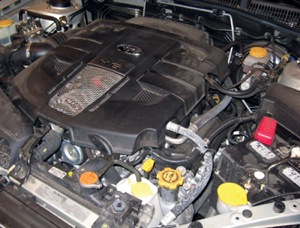 Just about any manufacturer can build a vehicle that will survive the initial warranty period with probably no service at all. There are still some people who try to make that happen, and then pass the car onto someone else to deal with the lack of care and the resulting damage.
Just about any manufacturer can build a vehicle that will survive the initial warranty period with probably no service at all. There are still some people who try to make that happen, and then pass the car onto someone else to deal with the lack of care and the resulting damage.
Getting Started
When I worked as a service advisor at a dealership several years ago, my approach was to listen to what customers wanted from their vehicles, mostly reliability and longevity, and then tailor the recommended services to fit their particular use of the vehicle.
I had a very loyal and friendly clientele, and was often given “difficult” customers because I took the time to work with them. Learning something about each customer, and determining how they’re going to use their vehicle, should influence how you service their needs.
In Western Washington where I live and work, that means taking into account the fact that about half of the people who live here probably spend the winter months skiing at mountain resorts that are thousands of feet above sea level, or spend their free time at sea level doing things on the water, like fishing or boating.
The other half spends a lot of their time just commuting at under 10 mph.
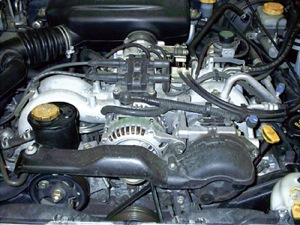 Determining the driving conditions makes all the difference in the world when it comes to the inspection and servicing of their vehicles.
Determining the driving conditions makes all the difference in the world when it comes to the inspection and servicing of their vehicles.
Subarus are particularly suited to the various uses indicated above. A look in the parking lot at one of the ski lodges is like looking at a dealership lot — with lots of Subarus topped with roof racks filled with skis, snowboards and storage lockers. Cars with rusty under-carriages, abused brakes, dented undercarriages and even sandblasted suspensions are just as common, as a lot of people spend time at the beach or try to find that secret fishing hole or campsite.
Going Under the Hood
As with most vehicles, oil changes and filter replacement will be the most common routine service. But, once you are “under the hood,” this is always a good time to check the vehicles out for other maintenance needs.
For example, most late-model Subarus with automatic transaxles have a spin-on filter on the transmission.
We’ve seen a number of these crushed by, we assume, inexperienced technicians mistaking that filter for the engine filter. If it’s damaged (it gets damaged when removed since it’s installed very tightly), it must be replaced with the proper automatic transmission filter. There is considerably more pressure inside the transmission than a normal engine filter would typically handle.
The design of all Subaru models over the last 15 years or so has been with the horizontally opposed 4- or 6-cylinder “boxer” engines. The design has a number of advantages, but for the technician, there are also some trade-offs. The good thing for most models is that the underhood area is open and all of the typical service points are on top and within easy reach (see Photo 1).
Even though most of the normal service points are in full view, removing the engine trim covers (see Photo 2) is a good idea to allow inspection of hoses, wiring or any indication that there may have been rodent nests started. For some reason, this has become a common problem. Some theories are related to the possibility that soy-based insulation has become a delicacy and is easier to digest than other plastics.
On the DOHC engines though, the spark plugs are in a very difficult and restricted position in the center of the cam covers. They’re usually easier to remove from under the car by removing the little splash panels under the radiator on each side. Using the correct socket match, extension and a universal will make this job easier, but by no means simple.
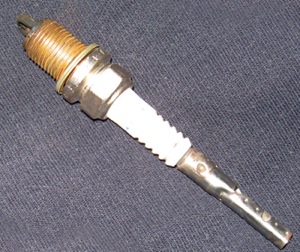 The first problem, especially on neglected engines, is getting the spark plug wires to release from the spark plugs. There is no recommended fix that seems to work; a boot puller, needle nose pliers or strong fingers have worked for me, but there can be problems like the terminal end coming loose from the secondary wire (see Photo 3), or just breaking off inside the boot. It’s a good idea to look into replacing the wires as a set where removal requires anything more than easy removal.
The first problem, especially on neglected engines, is getting the spark plug wires to release from the spark plugs. There is no recommended fix that seems to work; a boot puller, needle nose pliers or strong fingers have worked for me, but there can be problems like the terminal end coming loose from the secondary wire (see Photo 3), or just breaking off inside the boot. It’s a good idea to look into replacing the wires as a set where removal requires anything more than easy removal.
Since these engines do not have distributors with the problems of resistance in the cap and rotor, the plug wires are a lot more critical to the operation of the ignition system. For future removal (consider that you’ll be servicing this car for life), a coat of silicone paste on the rubber that goes over the porcelain part of the plug will make subsequent removal much easier.
One other area of concern under the hood is the ducting for the air intake. Some models used a MAF sensor at the air filter housing, with a long hose connected to the throttle body. If the hose is cracked or was left loose, there were obvious driveability issues. On later models, the air filter is attached directly to the throttle body.
The main thing to remember with any of these cars is that intake air leakage at any point will cause serious engine smoothness issues. Even a small vacuum hose leak on one side of the engine will cause an engine “rock” that can be felt throughout the car.
Another problem with the cars that have the air filter housing on the inner right fender is noise on acceleration. It can be a little tricky to get the cover back on correctly unless you loosen the clamps at both ends of the hose to the throttle body. This will allow you to get the lower edge of the filter cover properly installed over the tabs on the lower part of the bottom housing. Remember to retighten the hose clamps to prevent the intake leaks as noted above.
Cooling system service is pretty conventional, except there is a problem with getting the system completely full unless you use a vacuum-fill system and there are no leaks. Without the vacuum-fill system, the procedure takes patience to slowly fill the system and bleed off air with the bleeder screw in the upper hose neck.
Another trick here is to loosen one of the heater hoses at the back of the engine to bleed off air that might be trapped in the heater core if the system is fully drained. In either case, the car should be idled for awhile before driving to be sure the system did fill completely, allow the car to cool and then recheck before returning the car to the customer after a test drive.
I like to make sure the overflow bottle is about half full before a road test, just so there will be sufficient fluid to fill the system if an air pocket somehow makes it through all of the fill procedures.
Finishing Up
The number of Subarus sold in the U.S. in nearly 40 years will ensure repair work for the foreseeable future. As solid, dependable and useful cars, they can’t be beat. The company has stayed with the same basic design long enough that once you learn the differences between models, service becomes profitable and predictable for the shop and technician.
As I stated at the start of this article, with gas prices hovering close to $4 on average in the U.S., these cars will be the ones that people will hold onto, service and expect to hold up with normal maintenance. Keeping your customers will be easier if you learn to work with them in determining the proper way to service and maintain their vehicles, without forgetting to take into consideration how they use them.
The Boxer Engine’s Balance of Power
Subaru Boxer engines are mounted longitudinally in the chassis, resulting in better balance, reduced driveline friction and efficient power distribution. For added safety, the Subaru Boxer engine’s placement
minimizes the chance of harmful intrusion into the cabin during a frontal collision.
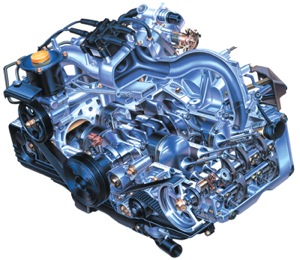 According to their engineers, these high-powered engines are ideal for all-wheel-drive applications used in Subaru vehicles because they are inherently compact — short and low. The layout concentrates its mass in a small area and contributes to a lower center of gravity.
According to their engineers, these high-powered engines are ideal for all-wheel-drive applications used in Subaru vehicles because they are inherently compact — short and low. The layout concentrates its mass in a small area and contributes to a lower center of gravity.
The 6-cylinder engine (H6-3.0L) used in such models as the Outback is compact in design and only slightly longer than the 2.5L 4-cylinder engine that powers other Subaru models (see illustration).
Mounting the boxer engine longitudinally (front to back) allows the transmission to be mounted directly behind it.
Since power travels in a straight, near-horizontal line to the rear differential, it helps minimize frictional loss.
This symmetrical, uniform layout also provides excellent left-right balance. By comparison, in a vehicle with a transverse (sideways) mounted engine, an all-wheel-drive system requires additional components to reroute the power from a sideways orientation to front-to-back orientation. Such a system adds friction (power loss) and extra weight on one side of the vehicle.
Recent years have brought a need for engines with better fuel economy and lower emissions. With this in mind, Subaru re-examined even the smallest details of its horizontally opposed boxer engine, which has undergone continuous improvement since its introduction more than 30 years ago. In the late 1990s, this scrutiny resulted in an important change in the piston design for Subaru engines that was nothing short of a “piston revolution.”
Piston Power and Crankshaft Secrets
Through experimentation, the engineers at Subaru discovered that a slightly barrel-shaped piston produces less friction, vibration and noise. The engineers then focused on improving the piston skirt (the lower part of the piston that makes contact with the cylinder wall).
In a radical break with convention, the skirt was made shorter and thinner to reduce weight.
Encouraged by the performance of their new piston, the engineers turned their attention to the cylinder.
Normally, gas builds up between the head of the piston above the compression rings and the inside wall of the cylinder. (The piston rings fit into grooves on the outer wall of a piston, just below the head. They seal the combustion chambers and the oil rings scrape excess oil from the cylinder walls.)
This unburned, compressed gas is difficult to combust because it is contaminated with leftover exhaust gases, and this reduces fuel economy. To prevent this problem, the gap between the head of the piston and the inside cylinder wall was made smaller, also making it necessary to reduce the piston pin offset and alter how the piston was weighted. These minute changes had an enormous effect on reducing the buildup of unburned, compressed gas.
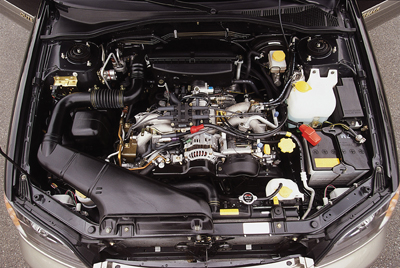 The crankshaft in a Subaru engine is short because a 4- or 6-cylinder horizontally opposed engine has two banks of two or three cylinders, rather than a long single row of four or six cylinders, as with in-line engines. Second, because the horizontally opposed engine is arranged symmetrically, the weight is more balanced than in in-line engines and the crankshaft needs no extra weight for counterbalance. These two features make the crankshaft both short and light, a significant advantage for any engine part that revolves at such high speeds.
The crankshaft in a Subaru engine is short because a 4- or 6-cylinder horizontally opposed engine has two banks of two or three cylinders, rather than a long single row of four or six cylinders, as with in-line engines. Second, because the horizontally opposed engine is arranged symmetrically, the weight is more balanced than in in-line engines and the crankshaft needs no extra weight for counterbalance. These two features make the crankshaft both short and light, a significant advantage for any engine part that revolves at such high speeds.
Subaru crankshafts are forged from an extra-hard chrome molybdenum steel, and the engine is designed with five main bearings to support the crankshaft. This combination produces a strong, durable engine. With regular maintenance, it is not uncommon for these engines to go hundreds of thousands of miles without major repairs.
Source: Subaru of America


